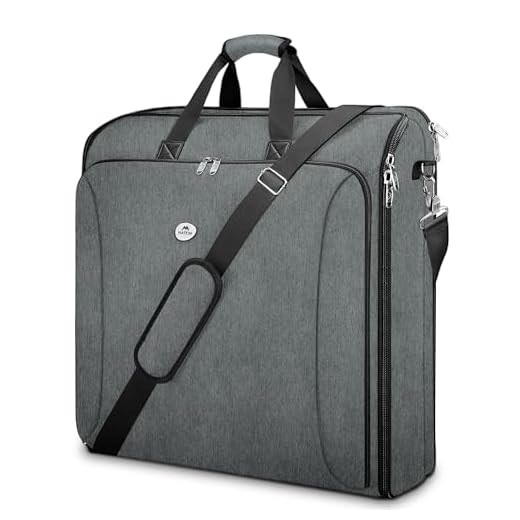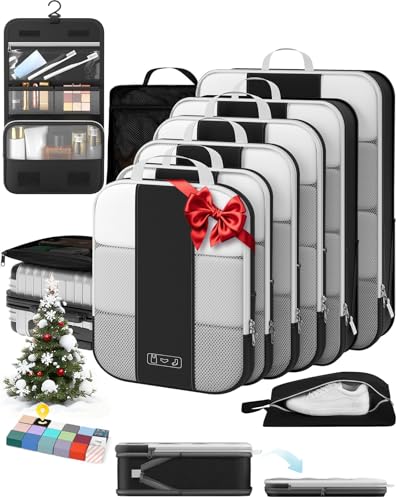





Begin by placing larger items, such as jackets and sweaters, at the bottom of your bag. This creates a solid base and helps maintain balance as you add smaller pieces on top.
Next, consider rolling garments like t-shirts and casual pants. This method not only saves space but also reduces wrinkles, ensuring your attire looks fresh upon arrival. For delicate fabrics, like blouses or dress shirts, place them in the center and layer them between sturdier pieces to protect them.
Utilize packing cubes to organize items by category or outfit. This approach simplifies access during the trip and prevents rummaging through the entire suitcase. Don’t forget to fill gaps with small items like socks or belts, maximizing available space.
Lastly, once your bag is packed, apply compression techniques. Close the suitcase and allow the air to escape, further optimizing your packing. This practical strategy keeps everything secure and organized, providing a well-structured travel experience.
Techniques for Packing Garments in Travel Bags
Utilize the roll method for maximizing space; tightly roll each item from the bottom up. This minimizes wrinkles while allowing for efficient storage, particularly in tighter compartments.
Incorporate packing cubes to organize various categories of attire. They help compress items and make retrieval straightforward, saving time during trips.
Employ the flat fold technique for dress shirts and blouses. Lay the garment face down, tuck in the sleeves, and fold from the bottom to the collar, creating a neat rectangle that stacks well.
Consider using compression bags for bulkier items. These vacuum-sealed pouches significantly reduce volume, leaving more room for essentials in the bag.
For delicate fabrics, use tissue paper between layers to reduce friction and prevent creasing. This is particularly useful for dresses or suits that are prone to damage during transit.
Organize by outfit rather than by type. This method not only conserves space but also ensures ease and quick access when it’s time to dress.
Make use of any available pockets or compartments in the bag for accessories such as belts, ties, or electronics, keeping everything organized and easy to reach.
Choosing the Right Folding Technique for Different Fabrics
For delicate materials like silk, utilize a soft roll method. Start by laying the garment flat, then roll it gently from the bottom. This approach reduces creasing and protects the fabric’s sheen.
For cotton and polyester blends, the classic rectangular method works effectively. Lay the item flat, fold sleeves inward, then fold from the bottom to the top, achieving a compact shape ideal for stacking.
Wool and Knit Fabrics
For heavier textiles such as wool or knits, opt for a tri-fold technique. Spread the garment on a flat surface, fold each side towards the center, then bring the bottom up to create a stable shape. This method preserves the structure and prevents stretching.
Activewear and Stretch Fabrics
Activewear, often made of spandex or similar materials, benefits from a loose roll. Lay the item flat and roll from the bottom, keeping it slightly loose to avoid damaging the elasticity. This technique saves space while maintaining the garment’s integrity.
Space-Saving Methods for Bulkier Items
Roll larger items such as jackets or sweaters to minimize space. This technique allows you to compress the fibers, resulting in a denser packing option compared to flat stacking.
Layering and Storing
Layer bulkier garments with lighter ones. Place softer items between heavier pieces for cushioning and additional protection. This layering method not only saves space but also protects delicate fabrics from potential damage.
Using Compression Bags
Invest in vacuum-seal bags. They drastically reduce the volume of bulkier items, making them easier to fit into tight spaces. Simply place the garments in the bag, seal, and use a vacuum to remove air, achieving significant space savings.
| Item Type | Folding Method | Space Saved |
|---|---|---|
| Jacket | Rolling | 30% more compact |
| Sweater | Layering | 20% more compact |
| Coat | Compression bag | 50% or more |
By implementing these techniques, you can maximize your packing efficiency, particularly when dealing with larger, bulkier items.
Organizing Clothes by Type and Occasion
Group attire based on purpose for streamlined packing. Create categories such as casual wear, business outfits, and formal attire to simplify selection during your trip.
Casual Wear
- Include versatile pieces like t-shirts, jeans, and lightweight jackets.
- Roll items to save space and minimize creasing.
- Pack a pair of comfortable shoes suitable for various casual settings.
Business Attire
- Use garment bags for suits and dresses to keep them wrinkle-free.
- Select neutral colors for maximum coordination and versatility.
- Add accessories like ties and belts in a separate pouch to maintain organization.
Formal Attire
- Choose fabrics that resist wrinkling, such as blends with synthetic fibers.
- Carefully place formal wear at the top of your bag for easy access.
- Consider using packing cubes to compartmentalize and protect delicate items.
By categorizing your ensemble based on type and event, retrieving the right outfit becomes straightforward, making your travel experience smoother.
Avoiding Wrinkles: Tips for Folding Shirts and Pants
To counter wrinkles, always begin with a flat surface. Lay shirts face down, smoothing out creases. Fold sleeves neatly towards the center, then bring the bottom up to meet the collar. This technique minimizes fabric overlap, creating a smooth profile.
For pants, start by aligning the legs. Fold one leg over the other, then take the waistband and fold it towards the hem, forming a rectangle. This method restricts movement and reduces the chance of creases forming during travel.
Selecting the Right Fabric Arrangement
Certain materials, like cotton, are more prone to wrinkling. To minimize this effect, stack heavier garments on top of lighter ones. Consider utilizing packing cubes for additional structure. If using a garment bag, hang items vertically to allow gravity to assist in keeping them wrinkle-free.
<h3.Using Protective Tools
Incorporate protective layers against potential creasing. For instance, consider rolling up soft garments, which can significantly reduce folds. Additionally, investing in travel essentials like the best vented travel umbrella can help shield against unexpected weather and protect your attire from moisture, while a best battery backpack leaf blowers helps keep your gear intact in outdoor scenarios.
Using Packing Cubes: Maximizing Space and Organization
Utilize packing cubes to create a tailored system for your belongings. These compartments allow for effective categorization and prevent items from mixing. Choose various sizes to accommodate different categories such as activewear, business attire, or casual outfits.
Optimizing Cube Arrangement
Place larger cubes at the bottom of the bag and stack smaller ones on top to establish a stable base. This arrangement conserves space and keeps the weight evenly distributed. Avoid overfilling individual cubes; leave some room for expansion, especially if purchasing new items during travel.
Color Coding and Labeling
Employ a color-coding system or labels for immediate recognition of contents. For instance, use blue for sports gear and green for formal wear. This method enhances accessibility and eases unpacking and repacking processes.
Secure a small mesh cube for toiletries and accessories to keep them separate from clothing, minimizing the risk of leaks and spills. Additionally, consider transparent or semi-transparent fabrics for easy visibility of contents without opening each container.
Travel-Specific Tips for Outerwear and Accessories
Prioritize lightweight and versatile outerwear that can be layered. Choose jackets that can serve multiple purposes, such as a waterproof shell that can be worn during rain and as a windbreaker.
Optimal Packing Techniques
- Use a compression sack for bulky jackets to save space and minimize volume.
- Position outerwear at the bottom of your bag to create a flat base for smaller items.
- Roll accessories like scarves and hats tightly to avoid creasing.
- Utilize every nook in shoes for storing smaller items like gloves or beanies.
Choosing Accessories Wisely
- Select multi-functional accessories; for instance, a scarf that doubles as a blanket.
- Limit the number of pairs of shoes. Ideally, pack one formal and one casual option.
- Be mindful of the climate; pack only what you’ll genuinely need.
Also, check whether are digital cameras recyclable to minimize waste while traveling.







